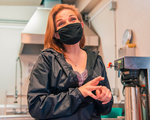



Brooke Reder’s path to recovery was a difficult one. After more than a decade in active addiction — using meth and heroin and living unsheltered in the Twin Cities for nearly five years — she now has more than two years of sobriety under her belt.
These days, her job is to connect locals to Gather Church’s new medication-assisted treatment clinic, and to walk side-by-side with them, hopefully all the way from addiction to recovery. Some of her clients are the same people she grew to call family: the people she camped with on the streets of Centralia, and the people she drank coffee with in the church’s Eat Free Cafe.
“We’ve lost a lot of people within a year and a half from overdose. And there are days where it feels like beating your head against a wall,” Reder said. “But then there are those days when someone gets it, and you can see that light switch is flipped … it’s the most beautiful thing to see someone go from active addiction to recovery.”
With the new “meds first” clinic, Centralia joins five other cities — Spokane, Walla Walla, Kennewick, Tacoma and Seattle — in a University of Washington study evaluating the low-barrier treatment facilities. The hope is to adapt the model researchers studied in Seattle to diverse communities.
Lead researcher Dr. Caleb Banta-Green, from the university’s Addictions, Drugs & Alcohol Institute, says the data could eventually inform a nationwide approach to the opioid crisis.
“People should be excited and proud that you have this clinic here,” he told The Chronicle. “You’re really trailblazers.”
Even before opening the clinic — in the midst of a pandemic and against a backdrop of increasing overdose deaths — Gather Church was working with locals suffering from addiction. Staffers provided food, clean clothing, fentanyl test strips, Narcan, wound care and clean syringes to fight against sometimes-deadly infections.
Sitting in his small office, situated behind the church’s kitchen and stacks of donated food, Gather Church Pastor Cole Meckle described some of those wounds evolving into sepsis and landing people in the hospital.
The program kept people from dying. But it’s difficult work, Meckle says, when he knows medication-assisted treatment would do so much more.
“Here you are, you know how benefited somebody could be by this (treatment) service, but you can’t even offer it to them,” he said. “I’m sorry, it just sucks.”
Without an accessible clinic, “all you can do is maybe try to compel somebody to white-knuckle it hard enough,” he said. “I’m trying to help them get clean, but I’m watching them, in some cases, die of an infection.”
The clinic — which doles out Suboxone, with the help of a care navigator, nurse and doctor — was the natural next step for Gather Church. Already, over 100 people have been connected with treatment. Funding from the Paul G. Allen Family Foundation, Premera Blue Cross and the state Health Care Authority made it possible.
“To see how much Gather has blossomed, and all the different things they’re doing, it’s beautiful. Because Lewis County needs it,” Reder said. “I feel absolutely blessed every day to be a part of it.”
In July, Gather will add even more community health workers, with the goal of connecting clients to counselors, intensive outpatient programs, and rapid HIV and Hepatitis C testing.
‘I Can’t Exaggerate That Problem’
Suboxone’s key ingredient, buprenorphine, significantly lowers the risk of overdose death, blunts withdrawal symptoms and ultimately helps people into recovery.
While buprenorphine was approved for use in 2002, it only recently gained significant traction. That’s partially due to federal restrictions — loosened last month by the White House — on who could prescribe the drug.
But beyond that, the traditional, primary care structure has also locked the drug behind a wall of bureaucracy, appointments and scheduling. While the setup may be tolerable to many patients, it’s a major barrier for those still struggling with addiction, homelessness or mental health issues.
“The system is not just inconvenient” for that population, Meckle said. “It’s impossible. I can’t exaggerate that problem.”
If you ask Banta-Green, there’s a reason the U.S. hasn’t made a significant dent in opioid overdose deaths: “and that’s because we’re still only reaching a small minority of people who would benefit from the most effective interventions.”
Banta-Green is an epidemiologist and former senior science adviser under President Barack Obama.
At Gather Church, it would be hard to make the clinic any more low-barrier.
“Literally, you can walk in with no address, no phone number, no insurance card, no nothing,” Reder said. And if the clinic’s care navigator, nurse and doctor determine medication is a viable option, “we can get you on Suboxone that night.”
Patients are then scheduled for follow-up visits. But missed appointments, unlike in some other treatment facilities, don’t result in patients being kicked out.
Many of the clinic’s patients are housing-insecure or homeless, but there’s a range of people coming in for help, and it mirrors the broad swath of Americans impacted by addiction.
Some patients have access to treatment in more traditional forms, like through a primary care provider. But the stigma of asking their doctor for help with their addiction leads them to Gather Church. Other patients are in their 70s, and for decades have been overprescribed opioids by doctors who later lost their licenses.
“Thirty years later, you’re barely hanging on, you can’t get your opiates anymore. Your options are finding a place like this, maybe getting into a prescriber that does (medication-assisted treatment) — but you probably have a pretty strong distrust at that point — or buying heroin on the street,” Meckle said.
‘A Stunner’
Findings in the ongoing University of Washington study are still preliminary. The project is slated to conclude in 2022. But one trend has emerged: about 60% of people engaging with the low-barrier clinics are getting started on buprenorphine their very first day.
“That’s a big-ass deal,” Banta-Green told The Chronicle. “That’s a stunner.”
But it’s not unsurprising given other data collected by UW’s Addictions, Drugs & Alcohol Institute.
A 2017 study on the majority of syringe services programs (SSP) in the state found that 78% of participants who used opioids wanted to stop or reduce their use. Sixty-nine percent of participants using heroin said they wanted medication-assisted treatment. And 59% said they needed medical care in the last year but didn’t receive it, often because they distrusted doctors or felt they would be judged.
Gather’s SSP offers a glimpse into the local level of need. In April alone, 285 individuals accessed the program.
And although SSPs — which often offer disease testing, education, and referrals to treatment — are supported by the state Department of Health, they’ve been a flash point in some places.
That includes neighboring Grays Harbor County, where new commissioners terminated their program this year, deeming it an inappropriate use of taxpayer money. The vote came despite pleas by the county’s current — and two former — public health directors, as well as state Health Secretary Umair Shah.
A local provider took charge of the program earlier this year.
In 2020, overdose deaths spiked more than 30% in Washington state. The trend is even more dramatic in Lewis County. According to coroner’s reports, overdose deaths skyrocketed from just five in 2019 to 29 in 2020.
And although research has shown SSPs are cost-effective, Meckle is hesitant to discuss the financial savviness of Gather Church’s program, saying the benefit to human life should be rational enough.
But still, he says Centralia’s SSP is a “fiscal no-brainer.” Supplies alone cost less than one overnight stay in the hospital. And the infections and illnesses that can arise without clean supplies — or wound care provided by Gather — can land people in the hospital for weeks.
All of the low-barrier clinics in the study are connected to an SSP. It’s vital, Banta-Green said, “in terms of providing non-judgemental services to folks in a trusting way.”
It’s also a unique part of the research. Banta-Green pointed to other public health approaches across the nation, where medication-assisted treatment is offered in hospitals, through direct outreach to homeless encampments, or in existing treatment provider settings.
“This work has been going on in a few places, and in a kind of ad-hoc way, often just in a reactive public health, medical way,” he said. “We’re doing a comprehensive study of it. So that’s another unique piece.”
‘A Living, Breathing Example’
Every other week, Reder hops on a call with the study’s five other cities. Researchers and clinic staffers are able to talk through what they’re seeing on the ground. It’s a major support system, Reder said. Especially in a field where you’re dealing with life and death.
“There are days where some of us are like, ‘we lost someone else.’ Or ‘damnit, this person relapsed,’ or ‘I don’t know how to handle this,’ or people crying on calls,” she said. “You want so hard for (clients) to see the light at the end of the tunnel … Sometimes you lose clients, which is a super bitter, hard pill to swallow, because you always think about what more could I have done?”
Researchers added care navigators to the low-barrier model in order to increase engagement: to get clients to come in, keep coming in, and have someone to guide them through their options.
And Reder’s lived experience is integral, Meckle said. When clients walk into Gather Church, looking to get into recovery but feeling like it’s impossible, “they’re sitting and talking to somebody who’s a living, breathing example. Right in the same room as they are.”
An abusive relationship is what started Reder down her path to methamphetamine and heroin. She lost her housing in Raymond, and when her now ex-husband went to prison, she signed away custody of her two kids — a nightmare that still visits her. After camping on the streets, or staying in hotel rooms when she could, a member of Gather’s congregation offered her a used RV. Church elder Triss Stanfield gave her a place to park it.
“That changed everything for me. I went from not having a place that I could literally call my own and knew that was safe, to having a space where I could lock the door and feel stable,” Reder said.
In many ways, Gather Church’s medication-first approach to addiction resembles the housing-first approach to homelessness, the idea being that housing — or stabilizing medication — should be a starting point. Then, individuals can begin to address deeper issues, sometimes involving trauma or mental health.
During some of Reder’s more than 12 years of active addiction, she said she had no love for herself. And feelings of shame — a sense that she was a burden — kept her from reaching out.
“I felt like I was such a disappointment to everybody in my life. That it would’ve been better if I didn’t wake up any more,” she said. “Every time I got loaded I knew I was losing more things and more people and burning more bridges.”
It was Gather Church that helped her into recovery. There, volunteering at the clothing bank and getting close with congregation members, she said she no longer felt like an inconvenience.
“That’s what it took: it took having people in my life that loved me unconditionally. Because they knew the good, the bad and the ugly,” Reder said. “They see me struggle with addiction and relationships and homelessness and my self worth and my mental health, and they never stopped loving me.”
It’s the kind of love she tries to give to her clients, who become mentees and even friends.
“You love them in whatever position they’re in in their life. And you love them continuously. And you don’t stop loving them until they can start loving themselves. And even at that point, you never stop loving them.”
Reder says her kids — now teenagers — are thriving. Her goal is to become a bigger part of their life.
Learn more about low-barrier buprenorphine at learnabouttreatment.org and more about Gather Church’s services at gatherchurch.com.